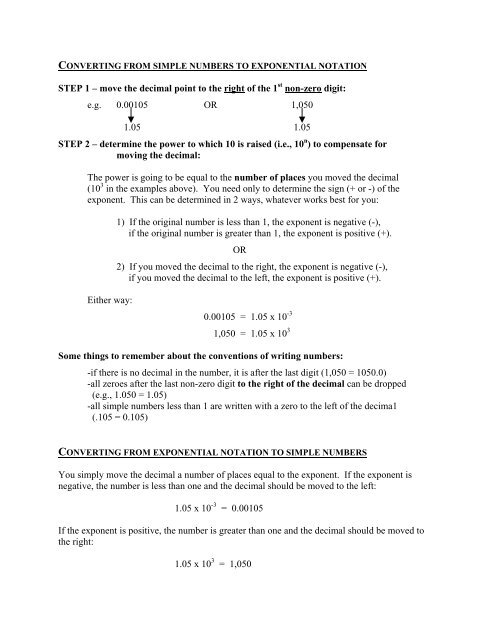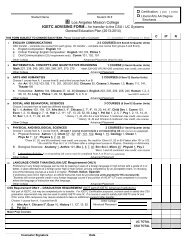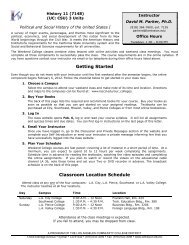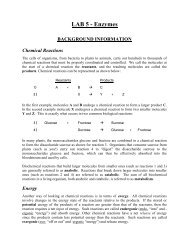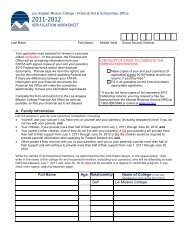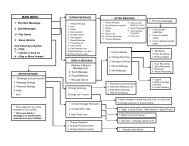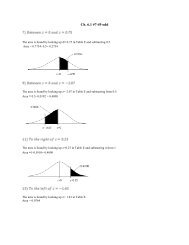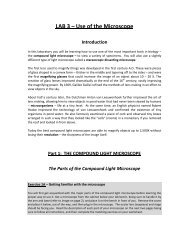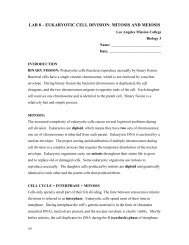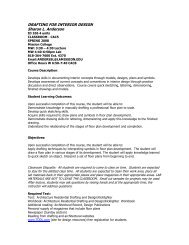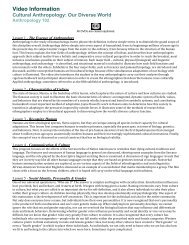Converting from decimals to scientific notation
Converting from decimals to scientific notation
Converting from decimals to scientific notation
You also want an ePaper? Increase the reach of your titles
YUMPU automatically turns print PDFs into web optimized ePapers that Google loves.
CONVERTING FROM SIMPLE NUMBERS TO EXPONENTIAL NOTATION<br />
STEP 1 – move the decimal point <strong>to</strong> the right of the 1 st non-zero digit:<br />
e.g. 0.00105 OR 1,050<br />
1.05 1.05<br />
STEP 2 – determine the power <strong>to</strong> which 10 is raised (i.e., 10 n ) <strong>to</strong> compensate for<br />
moving the decimal:<br />
The power is going <strong>to</strong> be equal <strong>to</strong> the number of places you moved the decimal<br />
(10 3 in the examples above). You need only <strong>to</strong> determine the sign (+ or -) of the<br />
exponent. This can be determined in 2 ways, whatever works best for you:<br />
1) If the original number is less than 1, the exponent is negative (-),<br />
if the original number is greater than 1, the exponent is positive (+).<br />
OR<br />
2) If you moved the decimal <strong>to</strong> the right, the exponent is negative (-),<br />
if you moved the decimal <strong>to</strong> the left, the exponent is positive (+).<br />
Either way:<br />
0.00105 = 1.05 x 10 -3<br />
1,050 = 1.05 x 10 3<br />
Some things <strong>to</strong> remember about the conventions of writing numbers:<br />
-if there is no decimal in the number, it is after the last digit (1,050 = 1050.0)<br />
-all zeroes after the last non-zero digit <strong>to</strong> the right of the decimal can be dropped<br />
(e.g., 1.050 = 1.05)<br />
-all simple numbers less than 1 are written with a zero <strong>to</strong> the left of the decima1<br />
(.105 = 0.105)<br />
CONVERTING FROM EXPONENTIAL NOTATION TO SIMPLE NUMBERS<br />
You simply move the decimal a number of places equal <strong>to</strong> the exponent. If the exponent is<br />
negative, the number is less than one and the decimal should be moved <strong>to</strong> the left:<br />
1.05 x 10 -3 = 0.00105<br />
If the exponent is positive, the number is greater than one and the decimal should be moved <strong>to</strong><br />
the right:<br />
1.05 x 10 3 = 1,050
CONVERTING UNITS WITHIN THE METRIC SYSTEM<br />
First and foremost, you need know (i.e., memorize) what each metric prefix represents:<br />
mega- (M) = 10 6 units<br />
kilo- (k) = 10 3 units<br />
BASE UNIT (no prefix) = 1 (i.e., 10 0 ) unit<br />
deci- (d) = 10 -1 units<br />
centi- (c) = 10 -2 units<br />
milli- (m) = 10 -3 units<br />
micro- (μ) = 10 -6 units<br />
nano- (η) = 10 -9 units<br />
When converting <strong>from</strong> one metric unit <strong>to</strong> another, simply move the decimal point a number of<br />
places equal <strong>to</strong> the difference* between the exponents associated with each prefix. When<br />
converting <strong>from</strong> larger <strong>to</strong> smaller units, the number should increase therefore the decimal<br />
should move <strong>to</strong> the right:<br />
e.g. 105 kg (105 x 10 3 g) = ____________ mg (? x 10 -3 g)<br />
-the difference between the exponents for each prefix is 6 (3 – (–3) = 6)<br />
-since you’re converting <strong>from</strong> larger <strong>to</strong> smaller units, the decimal is moved<br />
6 places <strong>to</strong> the right:<br />
105 kg (105 x 10 3 g) = 105,000,000 mg (105,000,000 x 10 -3 g)<br />
When converting <strong>from</strong> smaller <strong>to</strong> larger units, the number should decrease therefore the<br />
decimal should move <strong>to</strong> the left:<br />
e.g. 105 mg (105 x 10 -3 g) = ____________ kg (? x 10 3 g)<br />
-the difference between the exponents for each prefix is –6 (–3 – 3 = –6)<br />
*don’t worry about whether the difference is + or –<br />
-since you’re converting <strong>from</strong> smaller <strong>to</strong> larger units, the decimal is moved<br />
6 places <strong>to</strong> the left:<br />
105 mg (105 x 10 -3 g) = 0.000105 kg (0.000105 x 10 3 g)<br />
*The difference between 2 numbers is one number subtracted <strong>from</strong> another. Remember that<br />
subtracting a negative number is the same as adding a positive number (e.g., 3 – (–3) = 6). The<br />
easiest way <strong>to</strong> think of this is <strong>to</strong> use a number line:<br />
-6 -5 -4 -3 -2 -1 0 +1 +2 +3 +4 +5 +6<br />
The difference between 2 numbers for our purposes is simply the number of positions on the<br />
number line it takes <strong>to</strong> go <strong>from</strong> one number <strong>to</strong> the other.<br />
(e.g., <strong>from</strong> –3 <strong>to</strong> +3 is 6 places, <strong>from</strong> +3 <strong>to</strong> –3 is also 6 places)


